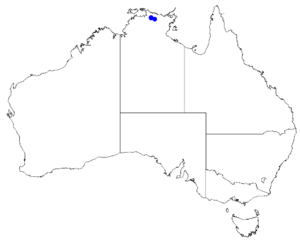Boronia viridiflora facts for kids
Quick facts for kids Boronia viridiflora |
|
|---|---|
| Conservation status | |
|
VU (TPWCA)
|
|
| Scientific classification | |
 |
|
| Occurrence data from Australasian Virtual Herbarium |
The Boronia viridiflora is a special kind of shrub. It only grows in a small area of the Northern Territory in Australia. This plant is unique because it grows sideways from tall rock faces. Its flowers are green with a hint of burgundy. They grow either alone or in small groups where the leaves meet the stem.
Contents
What is Boronia viridiflora Like?
Boronia viridiflora is a shrub that usually grows about 1.5 to 2 meters (5 to 6.5 feet) tall. It grows horizontally out from vertical rock faces. The plant is smooth and hairless, except for its petals.
Leaves and Flowers
Its leaves are shaped like an oval or a spear. They are about 8 to 40 millimeters (0.3 to 1.6 inches) long and 7 to 16 millimeters (0.3 to 0.6 inches) wide. Each leaf has a short stem called a petiole.
The flowers grow either alone or in groups of up to three. They appear where the leaves join the main stem. Small, leaf-like parts called prophylls surround the flowers. The sepals, which are like small leaves protecting the flower bud, are egg-shaped or triangular. They are about 3 millimeters (0.1 inches) long and 2 millimeters (0.08 inches) wide. These sepals are green and burgundy. The petals are green and about the same size.
When it Flowers and Fruits
This boronia flowers between March and September. After flowering, it produces a smooth, hairless fruit. This fruit is a capsule, which is a dry seed pod. It is about 5 millimeters (0.2 inches) long and 3 millimeters (0.1 inches) wide.
How it Got its Name
Boronia viridiflora was first officially described in 1997. This was done by a scientist named Marco F. Duretto. He published his description in a science journal called Australian Systematic Botany.
The plant's scientific name, viridiflora, tells us something important. It comes from two Latin words. Viridis means "green," and -florus means "-flowered." So, viridiflora simply means "green-flowered," which describes the color of its blooms.
Where Boronia viridiflora Lives
This special boronia plant is only found in two places. Both locations are in Arnhem Land in the Northern Territory. It grows on vertical sandstone rock faces. These areas are on land that is managed privately.
Why Boronia viridiflora Needs Protection
This plant is considered "vulnerable." This means it is at risk of becoming endangered if we don't protect it. It is listed as vulnerable under two important Australian laws: the Environment Protection and Biodiversity Conservation Act 1999 and the Territory Parks and Wildlife Conservation Act 2000.
Before 2006, scientists thought there were about 700 of these plants. However, a big storm called Cyclone Monica hit the area. This cyclone might have seriously harmed the plants. We don't know how many are left today.
The plants are also threatened by changes in how fires happen in their habitat. To help protect this species, a special plan has been created. This plan is called a National Recovery Plan. It aims to help Boronia viridiflora and another plant called Boronia quadrilata survive and thrive.
Images for kids



